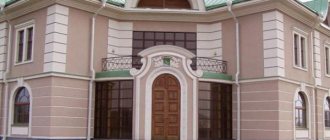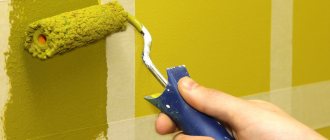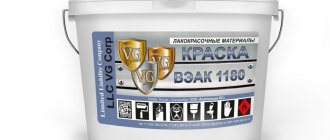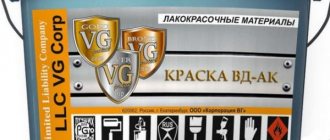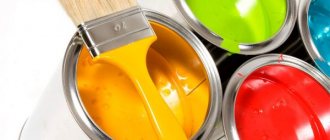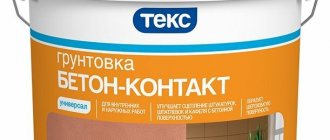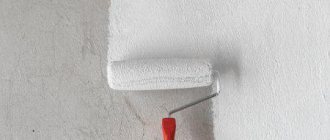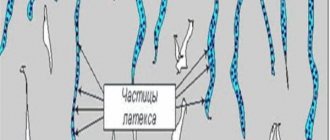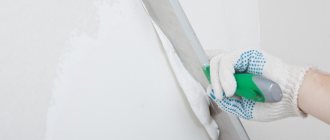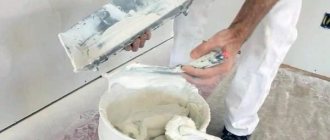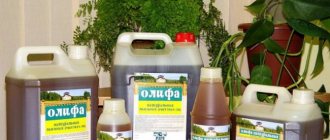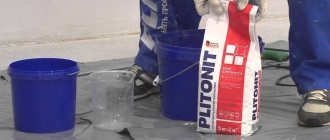What is the consumption of PF-115 paint per 1 m2?
Anastasia Isakova · Published 09/16/2017 · Updated 05/15/2018
Today, most people choose painting to decorate the ceiling and walls. To purchase the required quantity of any paint and varnish material, its consumption per 1 m2 is calculated. In this case, you should take into account the structure of the material and the specifics of the surfaces that need to be painted. What are the consumption rates for PF-115 paint per 1 m2 and how can I find out the exact indicator?
The abbreviation PF in the name of the enamel means PENTAPHTAL. It’s easy to decipher – the paint material contains alkyd resins and semi-dried oils, which allow the paint to dry quickly.
Where is PF 115 paint used?
Enamel PF 115 occupies a leading position in the market of paints and varnishes. If we describe it in one word, then the most appropriate one would be “versatility.” Used for painting any type of surface. The paint can be mixed with other compounds, as well as with a primer.
With the help of PF 115, the following types of work are carried out:
- interior painting;
- external finishing works;
- painting on metal, plastic and wood.
The material perfectly tolerates high or low temperatures, precipitation (rain, snow), and is resistant to UV rays. When applying enamel to the surface, a dense, smooth film is formed. Painting can be done using brushes and rollers. If you have a spray gun, spraying the composition over the surface is allowed.
On video: types of paints.
Scope of application
PF-115 belongs to alkyd enamels, as evidenced by the letter designation “PF”, indicating a pentaphthalic binder base.
Studying the numbers 115 gives us the following: by the first number we find out where the paintwork is applied. Thus, number 1 indicates that this is weather-resistant paint, which is recommended for use in outdoor work. The subsequent number 15 is the catalog serial number of the product, so these numbers do not contain any practical information. Although this alkyd paint boasts a wide range of uses, it was developed primarily for anti-corrosion protection of metal structures used in natural areas with temperate, cold or tropical climates.
It is used in the following industries:
- mechanical engineering;
- construction of highways;
- railway transport;
- machine tool industry;
- aircraft manufacturing;
- military-industrial;
- production of metal structures.
Due to the intense drying speed (about a day) and the rapid dissipation of the smell, this paint and varnish coating is often used for interior work. Paintwork materials are also suitable for treating wood, concrete, brick and other surfaces that are negatively affected by atmospheric influences, provided that the technology for preparing the surface for painting is followed.
PF-115 is rightfully considered a “people's” product. This paint is widely used by various utility services when there is a need to tidy up “irresponsible” objects such as various benches, fencing elements near entrances, basement doors, and protective grilles. It is indispensable for painting those products that need not only to provide anti-corrosion protection, but also to impart certain decorative qualities. In addition, PF-115 enamel is often used to paint wooden frames on windows or facades, so buildings quickly acquire a well-groomed appearance, and utility workers avoid unnecessary costs.
Most production facilities and warehouses are equipped with full-fledged heating systems. Since aesthetics plays a secondary role in such facilities, it is practiced here to install a large number of practical heating registers that maintain the optimal temperature in the room. They, along with cast iron radiators, are often painted with pentaphthalic paint, again for reasons of economy.
Consumption rates per 1m2
All of the above characteristics have a positive effect on enamel consumption. But if painting takes place in windy or sunny weather, the amount of paint used per m2 will double. Light-colored oil paint is applied in two layers; one will not be enough, as streaks and gaps will be visible. Therefore, when choosing white, gray or yellow, enamel must be purchased with a reserve.
If the paint needs to be applied in two layers, wait until the previous one has dried, and only then start working. It dries in about 24 hours.
Before painting, prepare the surface of the walls or ceiling. First, wipe it with a damp cloth to remove dirt and accumulated dust. In order to save paint and varnish materials, level the walls with putty and treat with a primer. Thanks to the primer, adhesion (adhesion) and service life of the material are increased.
The surface must be smooth, without flaws or cracks. The consumption of PF paint per 1 m2 will depend on the correct preparation of the walls and ceiling.
As practice shows, the rate of material consumption varies from 100 to 180 g. Also, professionals say that on average a can weighing one kilogram is enough to paint 15 m2 of prepared surface. Also, the consumption of PF 115 directly depends on the selected color pigment.
Table of approximate consumption of PF-115 enamel (depending on the selected color)
| Color | How much area is 1 kg of paint enough for? | Paint consumption per 1m2, g |
| White | 7–10 m2 | 100–140 g |
| Yellow | 5–10 m2 | 100–180 g |
| Green | 11–14 m2 | 70–90 g |
| Blue | 12–17 m2 | 60–84 g |
| Brown | 13–16 m2 | 63–76 g |
| Black | 17–20 m2 | 50–60 g |
You can reduce the amount of coloring composition if you choose a silicone-based roller to apply it.
A spray gun is also suitable; thanks to the fine dispersing jet, the enamel is applied evenly. Brushes absorb a lot of paint, which increases the consumption of material several times.
When calculating enamel consumption rates, add to the total amount the percentage of loss due to the location of the surface. If the floor is painted, the paint will not flow or drip, but for the walls and ceiling you will have to purchase extra material (approximately + 7%).
Do not forget that when painting a wooden surface, the paint will have to be applied in several layers, since wood, due to its uneven structure, absorbs a large amount of material. Consequently, paint consumption will increase. When covering metal surfaces, it is necessary to treat them from rust and contamination, and only then paint them with the desired shade. In some cases, one layer is enough. Plastic is less whimsical.
If you bought more paint than you needed, you can return it to the store within two weeks. To do this, the cans must be unopened; take the receipt for the goods and your passport with you.
Online calculator to help
There is another optimal way by which you can accurately determine the required amount of PF-115 paint. Consumption per 1 m2, as well as the total volume of required material, is calculated using an online calculator. It will help you perform the necessary calculations in a matter of seconds. You can use this calculator on our website.
In order for the calculation to be more accurate, you will have to indicate the necessary indicators in the table.
For painting walls:
- type of paint;
- length of the room;
- width of the room;
- wall height;
- window area;
- door area;
- number of windows;
- Number of doors.
For painting floors:
- type of paint;
- room length;
- width of the room.
The calculator automatically calculates the consumption per 1 m2 and the total amount of required material.
If you are planning to paint the walls or ceiling in your apartment, do not hesitate to invite workers. To calculate the consumption of PF-115 enamel, use one of the above methods. Select the shade of material you are interested in at a hardware store or market. The dyeing process itself will not take much time, so you can do it yourself, thereby significantly saving your family budget.
What does the marking PF-115 mean?
Well known to professional builders and owners of private houses, PF-115 enamel appeared on the market back in the 60s of the last century. Until now, it remains one of the most practical paints for various types of repair and construction work. The paint owes such durability not only to its low price, but also to a number of unique consumer qualities.
The paint has been produced virtually unchanged since the day it was first introduced to the market. Its composition is regulated by GOST 6465-76. If you want to use the classic PF 115, then buy paint made according to GOST. Many manufacturers make changes to the chemical composition and produce paint according to specifications. It is very difficult to guess whether its properties have been improved or worsened; it can only be verified experimentally. But there is not always time to do this, and not everyone can afford to buy paint, even inexpensive, for experiments.
The name PF 115 encodes the chemical composition and main areas of application. The index is understandable to a specialist, but does not mean anything to the average buyer. However, the information is very important.
The letter symbol PF indicates that the paint binder is pentaphthalic varnish (a type of alkyd resin). The scope of application of pentaphthalic paints is external and internal work on a wide range of materials.
The numbers 115 indicate the scope of application:
- 1 - for outdoor work in various climatic conditions;
- 15 - chemical composition number, determined by GOST and deciphered by the manufacturer.
According to its physical state, PF-115 paint is a suspension, a suspension of solid and liquid particles of various kinds in a liquid medium. The particles are represented by solvents, dyes, pigments, drier, titanium dioxide and other fillers. The base is a fairly viscous pentaphthalic varnish, which is dissolved with white spirit or other organic liquids.
Precautionary measures
When working with alkyd enamels, in particular with PF 115, the following precautions must be observed:
- The paint should be stored in airtight packaging;
- Take measures to ensure fire safety;
- Carry out painting work with protective rubber gloves;
- Avoid inhaling enamel fumes;
- After completion of work, ensure thorough ventilation of the room for 2-3 days.
Taking into account the above facts, we can conclude that alkyd enamel PF-115, developed in the USSR back in the 70s of the twentieth century, has not yet lost its relevance. The ability to use when painting any surface, the high quality and appearance of the resulting protective and decorative coatings ensured the wide popularity of the paint among the average consumer.
Video demonstration of removing PF-115 enamel using RIPAG remover
In addition, the favorable price/quality ratio allows domestic alkyd enamels to successfully compete with leading foreign manufacturers.
Technical characteristics of paint PF-115
As already mentioned, the paint has a number of properties that, in this combination, are quite unique, which allowed the composition to withstand fierce competition and last on the market for more than half a century. At the same time, enamel is one of the most popular, which in itself is a unique phenomenon.
We show the main characteristics of PF-115 paint in the form of a table:
| Mass fraction of non-volatile substances,% | 49-70 |
| Surface gloss, % | ≥ 50 |
| Conditional viscosity at T=20 0C | 60 -120 |
| Drying time at 20 0C, h | ≤ 24 |
| Flexural elasticity | ≤ 1 |
| Hardness, arb. units | 0,15-0,25 |
| Impact strength | ≥ 40 |
| Film adhesion level, points | 1 |
| Covering power g/m2 | 60 – 100 |
| Water resistance | ≥ 2 |
| Oil resistance, h | ≥ 24 |
| Resistance to detergents, h | ≥ 15 |
| Consumption, kg/m2 | 0,1 – 0,18 |
| Flammability group | flammable |
| Smell | pronounced |
| Toxicity | moderate |
Due to its properties, PF-115 enamel requires careful handling, especially when used in enclosed spaces. Before work, it is necessary to check the functionality of the ventilation and the absence of open flame sources. It is also not recommended to use heat guns, either liquid fuel or electrically heated.
Security measures
When painting, wear PPE (personal protective equipment) to protect against the harmful effects of toxic substances on the enamel.
After drying, there is no toxic effect.
It is worth using gloves, a respirator, safety glasses, and a suit. All this is necessary to prevent accidental contact of the composition with the skin or any mucous membranes.
When the enamel comes into contact with the skin, the affected area is treated with a solution based on just soap, slightly warm.
It is important to ensure good ventilation of the room, to provide artificial and natural ventilation:
- artificial - various ventilation systems, hoods;
- natural - open all windows and doors, thereby providing flowing ventilation.
We limit any contact and proximity to sources of fire.
Purpose and areas of application
Due to its high viscosity and excellent adhesion, the use of PF 115 paint is very wide.
The composition can be painted:
- tree;
- concrete;
- plaster;
- putty;
- brick;
- metal.
It is not suitable except for roofing work - when sheets of slate or tin are heated strongly, cracks may appear and the color may change greatly.
Enamel is used primarily for external work on structures located in the open air. It is used both as a monolayer coating and as part of multilayer coatings, in combination with primers, anti-corrosion and antiseptic impregnations, and insulating layers. Enamel does not have its own antiseptic and bactericidal properties, so when processing wood and walls made of brick or concrete in humid conditions, such additives are necessary.
PF-115 enamel has very high decorative properties - according to GOST 6465-76 it is produced in 22 colors and shades. In recent decades, manufacturers have offered modernized paint, which is available in almost all RAL colors. In this case, the color number from the catalog is indicated on the cans or barrels of paint. This is one of the few cases when it is preferable to buy paint made not according to GOST than standard. But it is necessary to take into account that this type of enamel costs more than usual due to the use of expensive dyes.
The high elasticity of the film, which can be obtained by painting surfaces in two or more layers (a single-layer coating is used only when updating a previously completed finish with the same paint, provided that there are no cracks or blisters on it) allows the use of PF 115 in completely different climatic conditions. The temperature range at which the finished coating retains its properties is incredible – 50…+60 0С. But the paint fully complies with the declared characteristics only if all technological rules for applying the coating layer are observed. We will tell you further how to use enamel correctly.
Positive Features
Depending on what kind of surface you need to get, you should choose enamel with a glossy or matte effect. White is used as the main color, but there are various shades on sale from which you can choose the one that suits you. The described enamel has the status of one of the leaders in Russian developments in the group of alkyd materials for painting. It can be used in different climatic zones, as it has the ability to withstand atmospheric influences such as solar radiation, snow, rain, wind and temperature variations. Thus, the coating on which the enamel has been applied can be used in the range from -50 to +60 °C.
After application, PF-115 enamel forms a durable coating that is resistant to water; in addition, after the paint has dried, the surface can be cleaned using detergents. The coating is not only high-quality and durable, but also looks great, looks uniform and has no streaks. The paint can be tinted in all sorts of colors and shades. If you apply it in 2 layers to a surface that has been previously primed and will be used in a temperate or cold climate, then the composition will not lose its protective abilities for 4 years.
Applications and recommended paint schemes
Waterproof alkyd enamel PF 115 can be applied with any type of painting tool - brush, roller, spray. When calculating the amount of paint required, you must definitely take into account the characteristics of the surface to be painted and the color of the paint.
Concrete, brick, unsanded wood absorb paint quite intensively and its consumption will be greater than when covering planed wood, metal or previously painted surfaces.
Selecting the amount of paint by color
Depending on the color, the consumption of standard paint is within fairly large limits. At room temperature, to paint 1 m2 of the same type of unprimed surface you will need:
0.1-0.14 kg - white paints
0.05 – 0.06 kg – black paints
0.07 – 0.1 kg – blue paints
0.07 – 0.08 kg – brown paints
0.1 – 0.2 kg – red paints
The calculation is given for single-layer painting. When determining the real one, the number of layers is multiplied by the given figures and again multiplied by a factor of 0.9 - each subsequent layer uses less paint than the first. The second coat can be applied no earlier than 24 hours after completion of the previous coating.
Only perfectly dry surfaces, heated to a temperature of at least +5 0C, can be painted. It is optimal to carry out painting work using PF 115 in dry, windless weather at an external air temperature in the range of +15 ... +22 0C. In this case, the paint will maintain optimal viscosity, the solvent will not evaporate too quickly from the surface, and the risk of drips will be minimized.
The method of application also affects paint consumption. If you use a roller, it will be larger than a brush, and a sprayer may lead to some overuse of the composition. Also, the average consumption directly depends on the quality of preparation of the surface for painting and compliance with standard paint application schemes.
Painting schemes with PF-115 enamel
1. Metal painting.
Metals of all types are painted with enamel only after priming with compositions GF 0119, VL 05, GF 021 or their analogues, compatible with pentaphthalic paints. In the index of primers, the first number must be 0. If there are no primers, and the surfaces are not very critical, then for the primer you can use PF 115 enamel itself, diluted with white spirit to 50% of the original density.
Surfaces bearing traces of corrosion are treated with rust inhibitors (converters) of the Unicor type before priming. These compounds are applied after mechanical cleaning of the metal from rust and fats. They transform corrosion products into strong and dense compounds, no different in hardness from solid metal. Metals are painted with PF 115 enamel in two layers.
2. Painting the wood.
On wood, enamel is applied without primer in 2–3 layers. If necessary (recommended), treat the wood surface with fire retardants, antiseptics and fungicides compatible with pentaphthalic paints. Manufacturers of paints and varnishes offer a wide selection of such compositions, but when using them, you must carefully study the instructions - some of them are intended for acrylic paints, some act as an independent coating.
3. Plaster, concrete, brick.
These materials are painted with enamel in 2–3 layers without primer. But it is advisable to use anti-mold preparations - enamel forms a dense surface with low vapor permeability and residual moisture can create favorable conditions for the development of mold and mildew in the material if pest spores remain there.
When painting any of the materials, the surface must be thoroughly cleaned of dust and dried. Residual humidity should not exceed 10 – 15%. Fresh concrete walls and foundations, as well as brick structures, can be painted no earlier than six months after completion of installation. The interval between applying the next coat of paint is at least 24 hours.
In most cases, paint is sold in factory containers completely ready for use. But after opening the can, the solvent begins to evaporate rapidly and the density of the enamel increases. To bring the paint to a working consistency, white spirit or solvent, as well as their mixtures, are used. Gasoline and kerosene are not recommended - although they dissolve the enamel, they significantly change its shade and shine.
When preparing paint for use, it must be thoroughly mixed, adding solvent in small portions. During the process, the paint also needs to be stirred periodically.
You might be interested Updated: April 06, 2021 40107 SHARE:
What is used to dilute enamel?
To dilute PF paint, white spirit or solvent is used. They can be combined in equal proportions. The use of gasoline and kerosene is not recommended because they change the color of the composition.
Despite the fact that PF enamels take a long time to dry and smell unpleasant, they are widely used in various fields. The reason for this is accessibility and high technical characteristics. Ease of application and resistance to external factors allows you to obtain a high-quality paint coating even in everyday conditions.
Technical characteristics of enamel paints PF 115 and their advantages
Anastasia Isakova · Published 05/13/2017 · Updated 07/03/2018
Alkyd enamels are very popular among other paints and varnishes. Even the appearance on the market of a more technologically advanced and environmentally friendly product, namely water-dispersed paints, has not reduced the demand for alkyd paints among domestic consumers. Let's see why these paints are popular - find out the composition, application possibilities, and technical characteristics of PF 115 enamel.
PF enamel paint was developed back in Soviet times, but this material is still produced today. The product is based on pentaphthal, hence the name. These paints and varnishes are used to treat various surfaces outdoors or indoors. The technical characteristics of this paint, as well as all properties, are regulated according to GOST 6465-76.
Alkyd enamels of this group are widely used for coating pre-primed metal, wood and any other surfaces.
GOST
GOST is a state standard that regulates the correct manufacture of products that meet all requirements, standards and technical specifications. In 1976, GOST 6465-76 was created for PF-115 by the Ministry of Chemical Industry, which stipulates all the conditions for production, transportation, storage, guarantees, and quality.
There are other GOSTs that mention the name of the enamel:
- 9980.1 – the rules for acceptance work are prescribed;
- 9980.2 – the order in which samples are taken for analysis is specified;
- 9980.3 – the rules of packaging and labeling are prescribed;
- 12.1.006 – the hazard classes of the constituent components of the enamel are described;
- 12.1.044 – description of fire hazard;
- 12.3.005b, 12.1.004 - a list of requirements, rules for the production, testing, and operation of enamel is prescribed.
Composition and labeling
In terms of composition, PF paint is a suspension consisting of pigments, as well as special fillers in an alkyd mixture. The base is PF-060 varnish and titanium dioxide. Fine dye. Paint markings allow you to read the basic properties.
This material consists of pentaphthalic varnish in the form of a semi-finished product, titanium dioxide, a solvent - white spirit or any other drier. The material also contains various modifiers that affect the color.
White enamel contains zinc white, gray enamel contains carbon black as a modifier, and iron glaze is used for blue.
In this case, enamel is directly a type of paint and varnish material. PF denotes the content of pentaphthals or binder base. The number 115 is the number of the color palette. The paint and varnish material is produced on the basis of GOST 6465-76, to which minor changes were made in 2001. These changes did not seriously affect the composition or features of the use of enamel.
Modern production produces two types of PF paint - industrial materials and retail. The difference is in production technology. Industrial coloring compositions are in the form of concentrates intended for dilution with solvents.
Distinguished himself well. The plant offers high-quality Enamel PF-115 MOKKE. This product is available in a wide range of colors and forms a super-durable, bright, durable coating. For a more reliable effect, it is recommended to pre-treat the surface with the same primer. Both enamel and primer are suitable for processing metal and wooden structures, indoors and outdoors.
The retail product already contains solvents, but additional solvent must be added to obtain the required consistency.
As for colors, alkyd enamel contains various color pigments, but it must be taken into account that they affect the performance characteristics. Cherry, black paints of the highest quality and grade do not exist - these colors are offered for sale only of the first grade.
The range of available colors is quite wide, but is limited only to full colors - there are practically no shades in the palette. If the desired shade is not available, it can be created by mixing two different colors.
Industrial paint is produced in the required colors in production according to GOST. In total, the palette contains about 20 colors.
What is alkyd paint
Alkyd paint is one of the universal paint and varnish coatings based on a solvent of organic origin.
Alkyd paint is one of the universal paint and varnish coatings based on a solvent of organic origin. Most often, purified kerosene is used as a solvent. In addition, the alkyd paint coating necessarily contains alkyd varnish, various fillers, coloring pigments and other components.
Specifications
PF enamel paint has certain characteristics:
- the film formed after application is glossy (gloss level is 50%);
- the adhesion level is no more than 1 point, but there are types of oil paints PF 115, where adhesion is lower;
- the paint contains non-volatile substances in a volume of 49% to 70%;
- bending elasticity characteristics are no more than 1 mm;
- characteristics of resistance to mechanical stress, shock - 40 cm;
- drying time at room temperature – no more than a day;
- specific hardness – 0.15-0.25 units;
- conditional viscosity level – 60-120;
- The coating can withstand exposure to moisture for 2 hours, lubricants for 24 hours, and aggressive detergents for no more than 15 minutes.
The paint can withstand any impact due to pentaphthalic varnishes and is characterized by high hiding power. The service life of the surface coating in low temperatures is at least 4 years; in hot climates, the coating lasts up to one year. At low temperatures, the paint layer does not change in any way. Also among the properties is resistance to fading.
If you take into account the composition of PF 115 enamels, you can clearly see that the material is fire hazardous and also quite toxic. When using these paints for indoor work, it is necessary to apply certain safety measures.
Advantages
The advantages include high quality paint and its characteristics:
- loyal price;
- weather resistance;
- moisture resistance;
- long service life;
- wide range of working surfaces;
- adequate consumption per square meter;
- high adhesive ability;
- elastic to expand or contract the painted surface;
- resistance to cracking;
- can be applied with different tools (brushes, rollers, spray guns);
- large color palette.
Paint application and consumption
Pentaphthalic paint is a universal material. It can be used, as already noted, for painting surfaces made of metal, wood, for external and internal work. The composition can be applied in various ways: with brushes or brushes, pouring, dipping, spraying. The mixture consumption is on average from 100 to 180 ml per 1 sq. m. m.
Consumption depends on paint color, density, and also on the area of the surface being treated. GOST 6456-76 indicates how much area can be processed for 1 kg of material depending on the color:
- white paint, weight 1 kg – area from 7 to 10 m2;
- black – from 17 to 20 m2;
- blue or light blue – from 11 to 14 m2;
- brown – from 13 to 16 m2;
- red – from 5 to 10 m2.
The peculiarity of PF 115 paint is its hiding power characteristics. Due to this, the average material consumption per 1 m2 is on average no more than 100 g. Larger consumption is only in special cases. The material fits perfectly on brick surfaces, concrete, and metal products. But in the case of brick and concrete, it is necessary to paint in several, usually two layers. In this case, the first layer must dry for 24 hours before applying the second layer.
You can paint anything indoors. But these materials are not recommended for floors due to their poor resistance to mechanical loads and force.
On the video: the area of application of enamel and approximate consumption.
Which manufacturer is better?
Without exaggeration, PF 115 enamel can be called legendary, which is why a large number of enterprises are engaged in its production. Below are the results of tests conducted by independent experts.
The drying time of enamels produced by POLIFARB and ZEBRA is practically the same and ranges from 20 to 23 hours, in addition, these enamels are easy to apply;
In the process of painting with enamels produced by DekArt, BARVA and DELFI, problems arise with uniformity of coloring, elimination of drips, streaks and brush marks;
All manufacturers provide high quality gloss, but special mention should be made of ZEBRA and MALVA;
Reliable information on paint consumption is provided by ZEBRA and MALVA.
The tests were carried out on the basis of the Physico-Mechanical Institute named after. G. V. Karpenko NAS of Ukraine.”
Depending on the color and class of enamel, the price of 1 kg can be from 60 to 170 rubles. You can find out more about the prices for the required paint on the website of the online store whose services you have decided to use.
Advantages and disadvantages
Having studied the composition of enamel 115 and technical data, we can highlight the advantages and disadvantages of this material. The first, serious and undeniable advantage is more than affordable prices, which makes alkyd paints an excellent choice for large-scale exterior finishing work.
Due to its composition, the product is resistant to moisture, various aggressive atmospheric influences, ultraviolet radiation, fuels and lubricants and even detergents. Temperature indicators at which this enamel retains its properties and characteristics are from 60 to -50 degrees. In countries with temperate climates, paint remains on the surface for more than 4 years.
Among the disadvantages is the drying time of about 24 hours. Also, not everyone will like the smell. A serious disadvantage is that it is difficult to wash off from hands and painting tools. Many painters prefer to throw away their brushes after working with these paints.
The composition is fire hazardous and toxic. Unlike PS enamels, the surface must be treated and primed before painting.
Peculiarities
To begin with, it is worth noting that it is more correct to call PF-115 enamel enamel paint, since there is a certain difference between these concepts. Enamel provides a stronger and smoother film on the surface than oil or alkyd paints.
Enamel paints come in several varieties:
- alkyd;
- pentaphthalic;
- glyphthalic;
- alkyd-melamine;
- alkyd-phenolic and alkyd-oil.
Pentaphthalic type of enamels is considered the most common and widely used in everyday life. In this group of paints and varnishes you can find a composition suitable for different types of surfaces (wood, concrete, metal, brick, chipboard, fiberboard, asbestos cement, plaster, oil or other paint, etc.). The color range of such enamels is truly limitless: the finished coating can be matte, semi-matte or glossy.
Enamel combines well with other types of finishing materials. This significantly expands the scope of its use. From an economy class material, it easily turns into an ideal option for decorating the most modern, original and fashionable interiors.
PF-115 enamel has proven itself and continues to hold a leading position among similar materials due to its impeccable performance and high decorative characteristics. Paint allows you not only to create a beautiful, smooth, shiny, glossy or discreet matte layer, but also to give the surface additional resistance to external influences, humidity, temperature changes, etc.
The popularity of this coloring composition has led to the fact that today not only large factories, but also very small companies are engaged in the production of this modification. Different types of enamels from this group have different alphanumeric designations that determine their properties and characteristics:
- the abbreviation “PF” denotes belonging to the pentaphthalic group of enamels;
- the first digit “1” indicates that the composition is intended for outdoor use;
- “15” is the serial number of the composition in the catalogue.
To get a complete picture of this material, it is necessary, first of all, to evaluate its advantages and disadvantages.
PF-115 enamel has a huge number of positive characteristics.
- Affordable price. An important factor when it comes to choosing a finishing material for a large amount of work or inexpensive repairs.
- Possibility of use for external and internal work. This means that the composition is moisture resistant, it is not afraid of UV rays, aggressive climatic conditions, temperature changes, etc. The enamel perfectly retains its performance characteristics in the range from -50 to +60°C.
- Wide range of colors. In addition, if it is necessary to obtain a certain shade, the enamel can be tinted perfectly at home.
- Easy to apply. The coloring composition is easily and quickly applied with different types of tools.
- Wear resistance. Enamel forms a fairly strong film on the surface that is resistant to mechanical stress.
- Protecting surfaces from mold and mildew.
- Durability.
- Corrosion protection.
- Resistant to gasoline and oils.
- Resistance to mineral fertilizers.
- Detergent resistant.
However, even this popular type of enamels is not without a number of disadvantages.
- The composition takes a long time to dry (24 hours). This point can be fundamental in some cases when it is necessary to paint and dry the surface very quickly.
- PF-115 enamel has a distinct, specific odor (not very strong, but quite noticeable for people prone to allergies).
- The enamel coating is very difficult to remove from hands and dirty instruments. Typically, builders prefer to throw away used paint brushes and rollers rather than bother with cleaning them.
- The material is toxic and fire hazard.
- Before applying enamel, it is necessary to pre-prime the surface to be treated.
What to look for when choosing?
Since the cost of these materials is affordable, low-quality compositions may be offered on the market. Quality characteristics are described in detail in GOST 6456-76. A quality product is offered at a price of at least 65 rubles per 1 kg. If the cost is 40 rubles or less, then you don’t have to read the description on the can - it’s a fake product.
It is easy to recognize a fake or low-quality enamels. There are several signs:
- Very strong solvent smell. White spirit is found in all types of enamel paints, but if the smell is too strong, the composition is of low quality.
- The film does not appear even after storing the open jar outdoors for a long time.
- The coating does not dry out for a long time even at high temperatures.
Tips and tricks
- The presence of a sharp, pungent odor. White spirit is included in many types of enamels, but an overly intense odor is a sign of a low-quality product.
- After opening the can and storing it in the open air, the original enamel is covered with film.
- If the coating does not dry even after 48 hours, then this is a very low quality product.
- Certificates of conformity, which the seller must have, will help you verify the quality of the products.
Most often, customer complaints related to the long drying time of the coating appear precisely after purchasing the material from dubious retail outlets.
Tips for working with paint
Before starting the painting process, surface preparation is necessary. It should be cleaned of dirt, old paint, and dried thoroughly. If you paint metal, it must be degreased and coated with anti-corrosion primers. Wooden surfaces are treated with drying oils or universal varnishes. Porous surfaces should be treated with alkyd primers.
Among the manufacturers Among the many products, we can highlight Enamel PF-115 MOKKE. It forms a super-strong, bright, stable coating and meets the requirements (GOST 6465-76). For a more reliable effect, it is recommended to pre-treat the surface with the Universal Primer GF-021 MOKKE. The products are suitable for processing metal and wooden structures indoors and outdoors.
The paint must be of the same brand. Primers when working with enamel are pentaphthalic.
What is the popularity of the product on the market? The demand for pentaphthalic enamels is easily determined by the emergence of new, higher-quality mixtures, the characteristics of which in terms of resistance to abrasion, moisture and durability are significantly increased.
Review of alkyd paints (3 videos)
Alkyd enamels of different brands (47 photos)
Popular posts
- Paint thinner pf 115 Paint thinners: selection criteria Now on the market you can find any material that you might like...
- Water-based paint for walls Menu Water-based paint is gaining more and more popularity every day Water-based paint for…
- Pf 133 technical characteristics Each paint has its own specific consumption and this depends on the specifics of the material itself and...
- How long does it take to dry PF 115 Oil paints: yesterday's paintwork materials or a current product? Have questions? Call! We are open: 09.00-18.00 (Mon-Fri),…
Painting
Before painting, the surface must be treated, which is necessary for the purpose of high-quality adhesion of the paint to it.
- The base must be cleaned of dirt, grease, dust and other contaminants. Used: washing powder, solution based on soda and soap.
- Old paint (solvent, sandpaper) is removed.
- The wood is sanded with sandpaper to a smooth surface, treated with drying oil, Biotex primer mixture or ordinary universal varnish.
- All traces of corrosion are removed from the metal, degreasing is carried out, and then an anti-rust metal primer is applied. For “unimportant” places, provided there is no primer, you can use the same PF-115, diluted 50% in white spirit.
- It is better to treat concrete, brick, and plastered surfaces with antifungal compounds against mold.
- Porous surfaces are treated with primers based on alkyd mixtures.
There should be no traces of dirt, dust, or moisture. The surface must be thoroughly cleaned and dried to prevent peeling of the enamel film and the formation of bubbles.
Procedure for priming:
- if necessary, the primer is diluted with a solvent and mixed;
- applied to the surface in a thin layer using a paint brush or roller;
- The mixture is expected to dry completely.
When using pentaphthalic primers, it is possible to apply them to an existing layer of paint, but pre-treated with sandpaper.
After preparation, painting can be carried out; ordinary painting tools are used - brushes, brushes, rollers, paint sprayers. If a small part is being painted, you can immerse it in a container with enamel and take it out - the immersion (dipping) method. Painting of metal primed surfaces takes place in 2 layers. For wood, concrete, brick and plastered surfaces, painting is required in 2-3 layers of 18-23 microns each. The thickness of the layer depends on the paint base and the color of the enamel.
Each new layer is applied only to the completely dry old one. PF-115 dries for 24 hours at room temperature. Only after this time can you begin repainting with a second/third layer.
The paint must dry completely. To speed up drying, it is permissible to heat the painted surface at a high temperature, up to 100°C.
